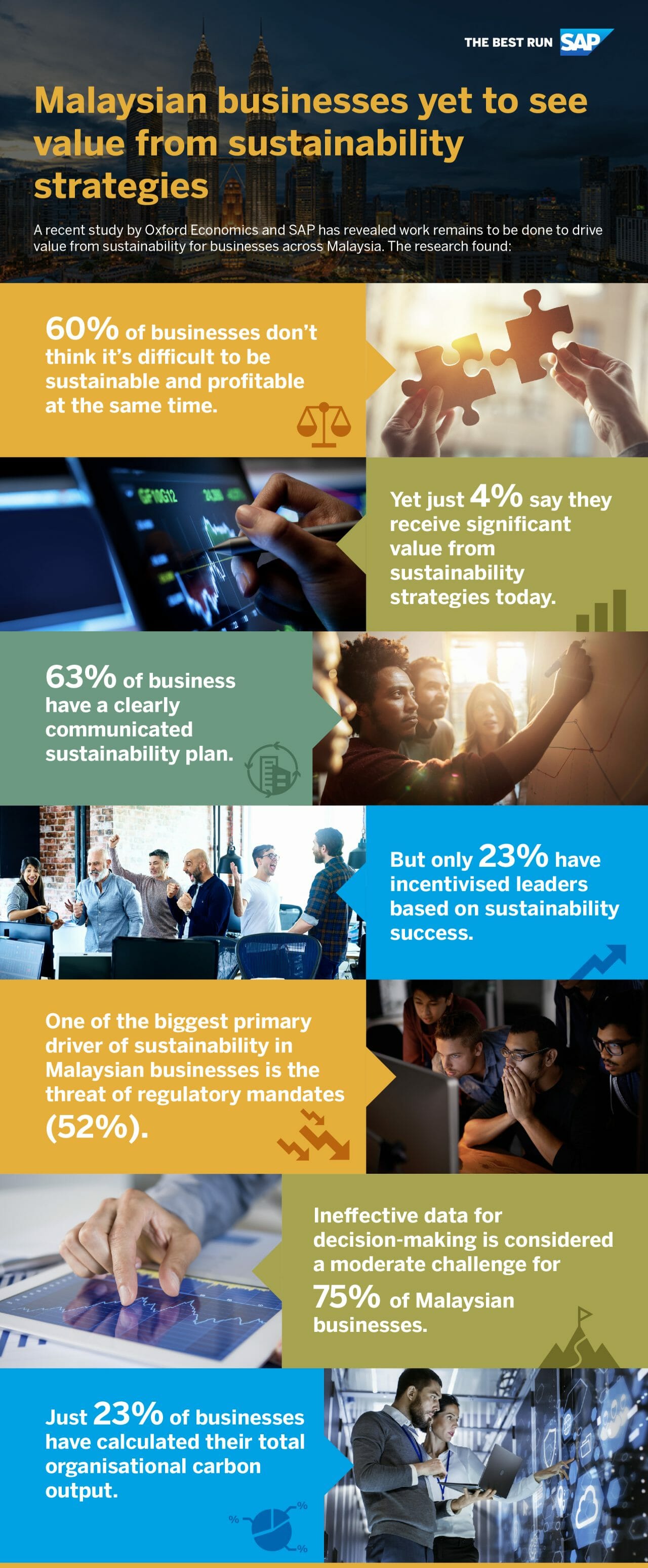Verena Siow, President and Managing Director of SAP South East Asia (pic), says that it is imperative for businesses to take the first steps into making sustainability a core part of their business strategies.
“Businesses cannot afford to wait for government and regulatory action. Our customers will start asking for our full sustainability ratings long before they take action and begin requiring reporting. The sooner we start on making sure that we are sustainable, the stronger standing and competitive advantage we will get in the market, and in the eyes of key stakeholders like the investors, customers and business partners.
“Businesses can start small to identify areas where sustainability can be embedded and work on the overall roadmap. This is a journey that starts now and will carry on for many years to come. As we all begin to do so, we will see the rewards of being more eco-friendly, winning the hearts of our stakeholders, and improving revenues and bottom lines.”
She said this during a recent media briefing on Closing the Green Gap held online, during which she shared some findings regarding the adoption of the sustainability agenda by businesses gleaned from research conducted jointly by SAP and Oxford Economics.
Siow notes that SAP’s focus on sustainability is part of the company’s 50-year mission of helping the world run better and improving people’s lives by focusing on business processes.
“We have been here in South East Asia since 1989. We have seen significant technical development and growth over the last few decades. And we expect ASEAN to be the fourth largest economy in the world by 2030, especially around the digital economy, reaching an expected $1 trillion, all enabled by cloud technologies.
“One of the top issues that we see in our region is around sustainability. While we see governments coming together and mandates imposed on organisations to chase net-zero and carbon neutrality goals by 2030, there is still a big gap in Southeast Asia on the ground. Quite often, the plan versus the reality is different.”
Siow believes that as businesses in Southeast Asia reinvent themselves in the wake of the changes brought about by COVID-19, the opportunity to embed sustainability as a strategic pillar of growth is important.
“As many companies ramp out sustainability agendas, the challenge is not just about going green, but how we deliver measurable outcomes and create meaningful impact for our societies for environment for our employees, and customers.”
According to Siow, the recent research by Oxford Economics and SAP to uncover significant barriers to sustainability initiatives centred around three areas.
“Firstly, what the shortfalls that keep companies from reaching the sustainability goals? Secondly, what are the steps to ensure holistic, integrated, and achievable plans? And finally, how do we drive success beyond compliance? We see the trend that many companies are embracing sustainability, mainly for compliance purposes. While that is well and good as the first step. We have to go beyond that and look about making sustainability profitable, as well as making a positive social impact to the world we live in.”
In this global survey comprising 2,000 top executives, 140 of them from Southeast Asia, Siow highlighted that 63% of them indicated that their companies did have a formal sustainability plan already in place, as published on their websites and other official document repositories.
“But there are still key issues between implementing the plans and reality. The top three challenges that we hear about are as follows: firstly, the lack of communication and engagement by executives, leading to a disconnect between the plans and the actions for many organizations. Secondly, ineffective use of data; siloed technologies that don’t share their information, and that includes accessibility to accurate data and inefficiencies in using the data, leading to poor decisions or no decisions. Thirdly, the lack of cross-country and industry collaboration and partnership. So it’s really, really important to drive that cohesiveness in the ecosystem. Not just within our organizations, but really with our partners, our suppliers, our business partners, to drive sustainable outcomes in totality.”
Siow goes into further detail on country-level findings, including more specific insights into Malaysia. “Sustainability strategies are largely being driven by regulatory drivers in Malaysia today. Survey respondents noted one of the primary drivers of sustainability in their business is the threat of regulatory mandates (52%), only behind operational efficiencies (54%) and ahead of market reputation (48%). That focus aligns with regulatory compliance being the second biggest benefit derived from sustainability so far (39%), behind only reduced carbon emissions.
“It’s clear that organisations may need to refocus their strategies to achieve greater value from sustainability. Too much focus on compliance was cited as the third highest challenge to sustainability success by Malaysian respondents, trailing only the lack of reinvention of business strategy and ineffective data,” she adds.
From the survey, sustainability ‘leaders’ (defined by the top 9% of all those surveyed) shared certain traits and behaviours that enabled them to have embraced comprehensive programs and are experiencing improved sustainability outcomes, business performance, and brand reputation as a result.
“This group of sustainability leaders have four behaviours. Number one; they set clear expectations about sustainably performance and communicate those expectations across the workforce. Number two, they apply technology and data management know-how in such key areas, leveraging technology and data management across the organisation. Number three, they engage with their core audiences and partners across the ecosystem, working closely with supply chain partners and policymakers to ensure that they are running the sustainability plan, and communicating it across not just within the organisation, but with the business partners and policymakers in those countries that they operate in. Fourth, but not least, is they create a system of records and accountability to ensure that sustainable efforts go beyond talk.”
Siow stresses that driving sustainability outcomes entails ensuring that it is a holistic integrated approach embedded within the DNA of the organisations.
“Sustainability leaders do enjoy robust bottom lines from those that we have surveyed; these companies are more likely than others to experience profit margins in excess of 10%. This in turn increases opportunities to create significant long-term value for these businesses, the people, and society as a whole. Businesses can realize new, sustainable revenue streams, optimize their costs, and find new efficiencies as part of the sustainability efforts as well.”
She also points out that SAP not only provides sustainability-related solutions to its clients and partners, but also deploys them within the organisation to make its own sustainability and ESG contributions.
“We can make sustainability profitable, and profitability sustainable as well. For SAP, we have launched a Chasing Zero initiative. And as part of that, we are implementing one of our solutions, SAP Sustainability Control Tower, in our own business to enhance our holistic business management, create insights on the total economic, social, and environmental impact our company has across a range of measures, and accelerate programs such as our ‘net zero emissions by 2030’.”
Besides the Sustainability Control Tower, SAP also has other solutions such as the SAP Product Footprint Management, SAP Environmental, Health, and Safety Management, as well as SAP Responsible Design and Production, which helps enterprises design out waste and regenerate natural systems, while providing greater visibility into material flows.
“All those solutions are built leveraging the SAP Business Technology Platform, many of them with our partners in mind, and beyond that, with the SAP portfolio in terms of our HR solution for SuccessFactors, or our Business Network Solutions under the Ariba network. At SAP, we believe in the power of our ecosystem and our wider community to realise the opportunity tomorrow as well as today.”










